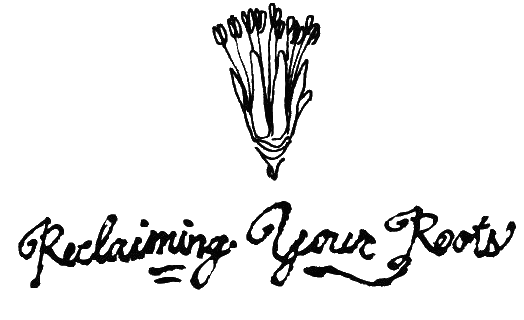Herbal Headache Remedies
It seems like I am often asked these days about natural headache remedies, and I myself have been exploring the subject of late to try and combat the sinus pressure headaches I get this time of year. Headaches can be debilitating for some and unfortunately long-term and regular usage of NSAIDS can wreak significant havoc on our digestive systems, livers, and more.
One of the most important factors in beginning to treat recurrent headaches is trying to figure out the root causes or triggers. Causes such as food allergies or intolerances, pollen, stress, hormonal imbalances, sleep deprivation, and other environmental factors often play a role. Working to eliminate as many of our headache triggers as we can is an important step. Fortunately, there are also quite a few herbal allies we can call upon to help us relieve these painful symptoms. Since this is a brief newsletter and a rather lengthy subject matter, I am going to focus on two herbs I have been working with of late.
Skullcap Scutellaria lateriflora
Parts used: Aerial parts
Medicinal uses: Skullcap is both a nervine tonic and an effective sedative. It’s one of the most versatile nervines and can be used to treat a variety of nervous system disorders. A part of the mint family, skullcap is easily cultivated in the garden, often reseeding itself, and grows wild throughout much of North America as well. Due to its antispasmodic properties, skullcap has a long history of being used to treat epilepsy, muscle spasms, Tourette’s, restless leg syndrome and nervous tics. It’s also beneficial for treating tension/stress induced headaches, insomnia, menstrual tension, anxiety, neck and back pain, and general nervous exhaustion. Its additional anti-inflammatory properties make it a great herb for alleviating menstrual cramping. To receive its full benefit, it’s best to use skullcap over a long period of time. However, it is also very effective in acute situations. When making a tincture, it is best to use fresh skullcap, as the dried herb loses much of its potency.
Dosage: For headaches, I prefer tincture. Tincture: 30-80 drops, up to 3x/day, Tea: 1-2 tsp per 8 oz water, 2-3 c/day
Contraindications: Can increase effects of prescription sedatives.
Rosemary Rosmarinus officinalis
Parts used: Leaves
Medicinal uses: One of our most common culinary herbs, rosemary also has a very long history of use as medicine. Energetically speaking, rosemary is a stimulating herb, having a warming and drying effect on the body. Rosemary is anootropic (“acting on the mind”) herb and has been used for hundreds of years for increasing cerebral circulation and treating poor memory, cloudy thinking, and depression, hence the old saying, “Rosemary is for remembrance”. Rosemary increases blood circulation through dilating blood vessels, making it a useful remedy for elders or individuals who are weak with symptoms of coldness, as well as for treating tension or sinus headaches. Rosemary acts on the nervous system as both a gentle stimulant, activating both the mind and digestive system in particular, and as a gentle sedative, relaxing muscle tension and spasms and helping to ground one’s mind and emotional body. Rosemary is particularly beneficial for individuals with weakened digestion. Its volatile oils stimulate the entire digestive system, promoting HCL acid production, increasing appetite, and alleviating gas, indigestion, and bloating. Rosemary is also a powerful antioxidant and anti-inflammatory. Studies have shown the carnosic acid it contains to prevent free radical damage in the brain (making it preventative for strokes, Alzheimer’s, etc.). It’s also a powerful antimicrobial herb, making it a great preservative for foods, massage oils, etc, as well as for using internally to fight off infection or externally for disinfecting a wound. Impressive right?
Dosage: For headaches, you can take a tincture internally: 20-40 drops, 3-4x/day or directly apply a small amount of tincture to the temples or sinuses. The tincture is quite potent so it’s best to start with a smaller dose. I also recommend working with rosemary essential oil for headaches. For external use, combine 2 drops of essential oil in 1 tsp of carrier oil (almond, olive, sesame, sunflower) and apply directly to temples and sinuses.
Contraindications: Not for use during pregnancy, except as a culinary spice.
Here are some other headache alleviating herbs and blends to try:
Headache Relief Tea
2 parts lemon balm
2 parts skullcap
1 part chamomile
1) Use 1-2 tsp of herb total in the above ratios. Infuse for 15-20 minutes and drink up to 3 c/daily. You can also make tinctures of any of the above herbs and make a tincture blend to take, 30-60 drops, up to 3x/day.
Essential Oils for Headaches
The essential oils below can all be applied topically to treat headaches. It is very important to add these oils to a carrier oil, like olive, sesame, sunflower, or almond oil. Applying essential oils directly to the skin can cause irritation and other issues due to how concentrated they are. I recommend adding 2 drops to each 1 tsp of carrier oil, mixing and then applying to the temples or sinus areas (wherever the headache seems to be sitting). You can blend any of the oils below together or use them separately. I typically work with Rosemary.
Peppermint
Eucalyptus
Rosemary
Lavender


